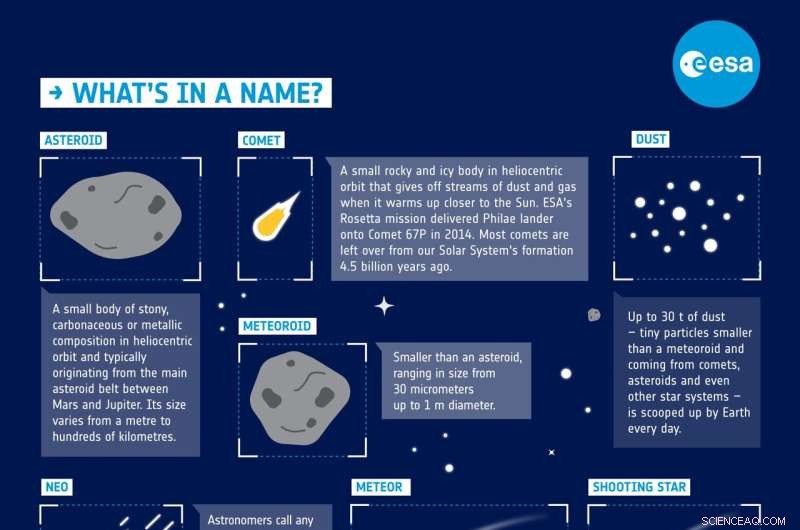
Proprio come ci sono una varietà di piccoli corpi che attraversano lo spazio, gli scienziati hanno una serie di nomi diversi per loro. Questa pratica infografica illustra cosa succede nell'affascinante mondo delle rocce spaziali. Credito:ESA
Una palla di fuoco avvistata su Madrid ha portato alla luce i suoi antenati astronomici. Mentre ha terminato i suoi giorni di combustione nell'atmosfera terrestre il 31 luglio di quest'anno, il frammento ha iniziato la sua vita come parte della cometa 169P/NEAT, responsabile dell'annuale pioggia di meteoriti Alpha Capricornids.
Gli sciami meteorici si verificano quando la Terra passa attraverso il percorso disseminato di detriti di una cometa, che avvicinandosi al sole e ai ghiacci "sublima" da solido a gassoso, emette un flusso di materiale che rimane sul posto. Quando questi oggetti entrano in collisione con l'atmosfera terrestre, bruciano come meteore brillanti, le più luminose delle quali sono conosciute come palle di fuoco.
Tali docce ricordano periodicamente che la Terra sta attraversando un ambiente cosparso di antichi resti del primo sistema solare. Sebbene siano al sicuro, questi impressionanti spettacoli di luci offrono un avvertimento, poiché questi tanti piccoli frammenti nascondono gli oggetti più grandi da cui provengono e che una volta sono passati vicino all'orbita terrestre, e potrebbero farlo di nuovo.
Utilizzando filmati provenienti da telecamere a terra in tutta Europa, tra cui una telecamera gestita dall'ESA della rete AllSky7 a Cebreros, in Spagna, e telecamere nel Southwestern Europe Meteor Network (SWEMN), la traiettoria della palla di fuoco è stata calcolata da SWEMN e le sue origini sono state tracciate tornare in tempo. Entering the atmosphere at a height of 100 kilometers over Madrid and burning up at 77 kilometers above the Spanish province of Guadalajara, the icy body is thought to have been about 10 cm in size before contact with Earth.
It is thought that the Alpha Capricornids meteor shower was created 3,500 to 5,000 years ago when half of Comet 169P/NEAT disintegrated and fell into dust. The comet itself will have formed at the same time as our solar system, around 4.6 billion years ago.
The dusty trail from this ancient comet has drifted into Earth's orbit creating infrequent but reasonably bright meteors. At its peak, only it creates only about five meteors per hour, but these are usually very bright and often become fireballs; particularly bright meteors.
As this drift continues, the shower is expected to get stronger. By the year 2220, it should be stronger than any current annual meteor shower. For now however, you can catch it in its current form until about 15 August. + Esplora ulteriormente